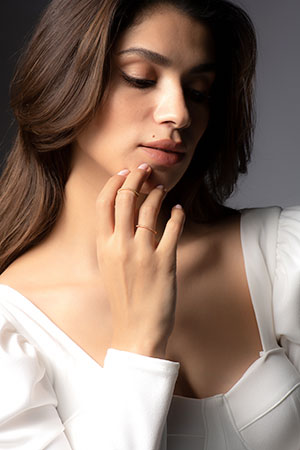Why Are Gold Colors Different?

Gold is a malleable metal that is bright yellow in its pure state and changes color when mixed with different alloys. For centuries it has been seen as a precious metal; because it does not react easily, so it does not tarnish and rust. For this reason, gold is a very suitable option for accessory use today. In order to turn gold into an accessory, it is necessary to mix it with different elements; because in its pure state, gold has a very soft structure. Depending on the type and density of the alloy, variations in the color of gold may occur, and as the density of different elements in the alloy increases, the gold color show changes from its metallic yellow color.
What Alloys Are Included in the Gold?
Since gold cannot be used in its pure form, it is made solid with different alloys. These alloys include silver, nickel, copper and palladium. The question of what is the color of pure gold is often a matter of curiosity. Pure gold has a metallic and yellow color. In different alloys, this color may evolve into different tones. For example, the gold and silver alloy known as green gold contains 75% gold and 25% silver. An alloy of gold and nickel is often used in jewelry making and contains 80% gold, 16% nickel, 3% zinc and 1% copper. The percentage of gold purity in these alloys determines the carat of gold.
Yellow Gold
The color of pure gold is known as metallic yellow. One of the most preferred colors for accessories is yellow. The proportions of this gold, which contains silver and copper alloys, determine the carat of gold. The yellow gold can be turned into white gold with elements such as zinc and palladium. White gold is often seen as a more preferable option from an aesthetic point of view. Besides this, while evaluating purity ratios, we may say that yellow gold will always be purer than white gold.
Green Gold
Green gold is a frequently preferred type of gold in the field of jewelry. Changes in gold color can only be possible by changing the proportions and types of gold components. An alloy of yellow gold and silver creates the green color. The question of what is Green Gold is often asked. Green gold is an alloy formed by using 75% gold and 25% silver and is mostly used in jewelry making. Green gold, also known as 14-karat gold, which has a very elegant appearance in terms of aesthetics, is among the most preferred gold types as accessories.
White gold
Questions such as what is white gold and how is white gold made may stay in your mind as a question mark. Gold is essentially a yellow metal. The process of turning yellow gold into white gold is carried out with elements such as zinc and palladium. Like green gold, white gold is often used in jewelry making, and when its purity ratios are evaluated, yellow gold is more pure than white gold. Transforming yellow gold to white gold is a process that can be done later; however, the white color obtained after this process is temporary. For a permanent whiteness, it is necessary to prefer alloys made with elements such as zinc and palladium.
Rose Gold
The question of what is rose gold is also a subject that jewelry lovers wonder. Rose gold, also known as red gold, is a type of gold obtained by mixing 0.6% silver and 19% copper into pure gold. It has a very elegant appearance in terms of aesthetics. For this reason, rose gold is a type of gold that is often preferred as an accessory. Giving rose gold appearance to already owned silver accessories is a frequently preferred method; for doing this the silver accessory is covered with rose gold so that it can be used for a long time without oxidation.
What is the Color of Pure Gold?
The color of pure gold is metallic yellow, which is mentioned in the literature as golden yellow. In traditional jewelry, it is called pure gold. The question of whether the color of yellow gold fades is wondered by users. High-carat yellow gold does not fade, does not oxidize and does not rust for many years. Gold has been used as a currency for many years due to its durable structure and has been evaluated as one of the most valuable metals in a time period that will last from ancient times to the present. For this reason, it is possible to say that the purity rate of gold that fades in a short time may be low. It is normal for gold to darken and fade over a long period of time; such situations can occur no matter how pure the product is. In such cases, you may consult us to get information about the way to be followed for the care and polishing of your jewelry; Piano Jewelery is ready to serve you with pleasure.
Is It Possible to Change the Color of Gold?
The gold color can be changed by plating afterwards; however, this may not be a permanent application. In order for the gold color to be permanently changed, the alloy must be arranged accordingly. A permanent color can be achieved by adding to the alloy the elements suitable for the colors desired to be obtained during the production phase of the product. The color of already existing gold can only be changed by plating; this may not provide a permanent color change. For this reason, when choosing a product, it is recommended to choose products in the color that suits your demands from the very beginning.











































































































